Claire Sewell / June 18, 2018
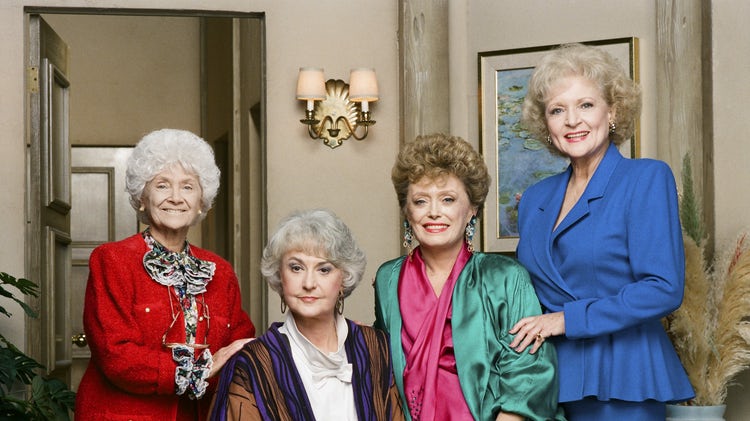 The Golden Girls premiered on American television’s NBC network in September of 1985. The sitcom features four women—Dorothy and Sophia Petrillo, Rose Nylund, and Blanche Devereaux—who are older, single, and living together as friends in the popular retirement locale of Miami, Florida. A TV Guide cover from the time questioned “their no-spring-chicken humor,” but the show was an instant hit and ran for seven seasons. Each actor was a veteran of both stage and screen so, as a sitcom, The Golden Girls had that perfect combination of talent and humor that allowed it to remain popular over the years in syndication. Hulu also reignited interest in the show with a whole new generation when it began streaming all 180 episodes in 2017.
The Golden Girls premiered on American television’s NBC network in September of 1985. The sitcom features four women—Dorothy and Sophia Petrillo, Rose Nylund, and Blanche Devereaux—who are older, single, and living together as friends in the popular retirement locale of Miami, Florida. A TV Guide cover from the time questioned “their no-spring-chicken humor,” but the show was an instant hit and ran for seven seasons. Each actor was a veteran of both stage and screen so, as a sitcom, The Golden Girls had that perfect combination of talent and humor that allowed it to remain popular over the years in syndication. Hulu also reignited interest in the show with a whole new generation when it began streaming all 180 episodes in 2017.
The Golden Girls remains an important television show, not just because it features a cast of four older women with vibrant lives and experiences, but also for the groundbreaking ways that it tackled difficult, sometimes politically charged issues, thanks to creator Susan Harris’s progressive vision. Younger viewers watching the show for the first time are often surprised to see topics such as AIDS, gay marriage, immigration, antisemitism, and sexual harassment—all still just as relevant today—treated with sensitivity and insight. It is also particularly striking to remember the many significant political and social events that took place when The Golden Girls originally aired: the Iran-Contra affair; the Space Shuttle Challenger disaster; the fall of the Berlin Wall; the “end” of The Cold War; the Gulf War; and Anita Hill’s groundbreaking allegations against Clarence Thomas, to name a few. Perhaps the same could be said of any sitcom during this time period, but The Golden Girls continues to enjoy a unique popularity among viewers because it positioned itself among relevant events rather than existing in a wholly fictional universe. Viewers therefore see the Girls not as fictional grandmothers but as friends, just as in the show’s famous theme song.
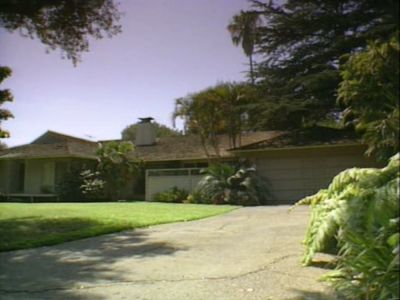 The show took place on one of the most memorable sets in television history—yet another reason for its longevity and relatability. The many nostalgic elements present throughout the set allow longtime fans to center it in their minds as a comfortable, homey space. To younger viewers, such elements may seem more retro than nostalgic, yet the overall atmosphere of the set revels in an almost universal appeal that harkens back to a more personable interior design philosophy. There is no aspirational design here. The set feels familiar precisely because many viewers had at least some personal experience with a home like the one the characters lived in. Although the size, condition, and location of the Girls’ home reflected a decidedly middle to upper middle class income bracket that not all viewers may have belonged to, choices such as color schemes and decorative accents reinforce memories of the set in the minds of viewers. It is also important to remember that the Girls’ living arrangement reflected their circumstances as single women who, for various reasons, needed to continue working and sharing living expenses.
The show took place on one of the most memorable sets in television history—yet another reason for its longevity and relatability. The many nostalgic elements present throughout the set allow longtime fans to center it in their minds as a comfortable, homey space. To younger viewers, such elements may seem more retro than nostalgic, yet the overall atmosphere of the set revels in an almost universal appeal that harkens back to a more personable interior design philosophy. There is no aspirational design here. The set feels familiar precisely because many viewers had at least some personal experience with a home like the one the characters lived in. Although the size, condition, and location of the Girls’ home reflected a decidedly middle to upper middle class income bracket that not all viewers may have belonged to, choices such as color schemes and decorative accents reinforce memories of the set in the minds of viewers. It is also important to remember that the Girls’ living arrangement reflected their circumstances as single women who, for various reasons, needed to continue working and sharing living expenses.
Viewers and fans of the show often remark that its aesthetic is quintessentially 1980s, but the sets were in fact thoughtfully constructed to portray a suburban design sensibility that would have manifested in the 1970s and earlier. So, although the show first aired in 1985, the sets needed to look as though they were constructed in prior decades. The house that was originally used for exterior shots is a ranch-style built in 1955 and located in the famous Los Angeles neighborhood of Brentwood (later seasons featured a recreation built on a Disney lot in Florida). Based on dates mentioned on the show and Blanche’s surprisingly complete Wikipedia page, it would seem that she and her late husband, George, probably would have moved into the house in the early 1970s. Of course, we can also assume that they would have done some updating and redecorating upon moving in. There is less scholarship available that specifically focuses on set design for television, so it makes sense to consider interior design texts as source material, because they reveal history and changing tastes that influenced art direction choices. One such source is The Practical Encyclopedia of Good Decorating and Home Improvement. Published in 1970, it is an eighteen-volume holy grail of interior design and decorating ideas that brings together influences from the 1950s and ‘60s into a fantastically astounding set of books. It’s all too easy to poke fun at some of the motifs now, but one look through any of the volumes will send you hurtling back through space and time to memories of a residence in your own past.
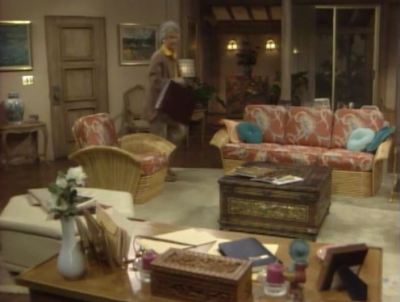 It’s no wonder that The Golden Girls set has become so iconic, really—the show’s production designer, Ed Stephenson, was already an accomplished art director when he started working on it. He won his first Emmy award in 1959 for An Evening with Fred Astaire, and went on to win two more over the course of his career. Stephenson had previously worked on both The Betty White Show and Maude, among many others. He was also nominated for an Emmy for Outstanding Art Direction for a Series for his work on the pilot episode of The Golden Girls. From the very first scene of the pilot, “The Engagement,” viewers are introduced to carefully planned design elements such as the bamboo sofa and chairs that would become hallmarks of the set.
It’s no wonder that The Golden Girls set has become so iconic, really—the show’s production designer, Ed Stephenson, was already an accomplished art director when he started working on it. He won his first Emmy award in 1959 for An Evening with Fred Astaire, and went on to win two more over the course of his career. Stephenson had previously worked on both The Betty White Show and Maude, among many others. He was also nominated for an Emmy for Outstanding Art Direction for a Series for his work on the pilot episode of The Golden Girls. From the very first scene of the pilot, “The Engagement,” viewers are introduced to carefully planned design elements such as the bamboo sofa and chairs that would become hallmarks of the set.
Other elements of the set would change during the course of the show, some making only one appearance (along with Coco, the gay houseboy). The imposing coffee table from the pilot is one example. It sticks out because it doesn’t seem to go with much else in the room and is reminiscent of the dark wood paneling that often dominated 1970s interiors. By the second episode, it would be replaced with one that matched the sofa and chairs for a more modern look. I don’t think the top of the television is ever seen again after the pilot, but it too is familiar to many viewers who remember those behemoth encased console sets.
All sitcom sets require some suspension of belief in order to accommodate filming, and the kitchen on The Golden Girls is no exception. For instance, it’s often noted that there was no fourth chair at the table. This was a necessary aspect of filming scenes in this room, but it also allowed for a unique situational perspective in which one or more characters could provide additional action around the room. The set was recycled from another NBC sitcom of a few years earlier, It Takes Two.
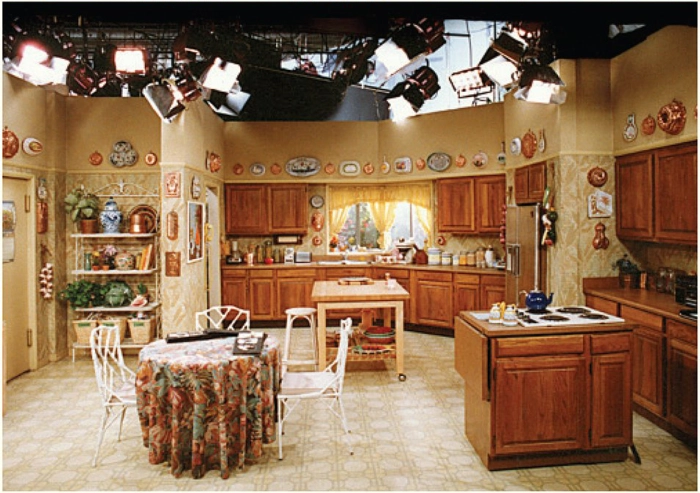 Although the photo above is from the 1990s (this is evident due to the appearance of the recycling baskets on the baker’s rack, not present in the 1980s), the cabinets are definitely right in line with a typical early ‘80s home remodel. The faux-wood paneled side-by-side refrigerator with built-in ice dispenser is an especially modern touch. The dishes hung above the molding recall plate rails—a decorating feature that originated in the 1800s—will likely connect with many viewers (including myself). The table at which the Girls ate all those cheesecakes was covered with a tablecloth following the pilot. It’s actually clear glass underneath that, while on trend for the time period, proved distracting on film. Bric-a-brac was also a hallmark of interior design from the 1960s through the 1970s. Such arrangements of picture frames and knick-knacks often recalled salon-style art exhibitions that were popular in the 19th century, when artworks were grouped together rather than displayed, museum style, in straight lines at eye level.
Although the photo above is from the 1990s (this is evident due to the appearance of the recycling baskets on the baker’s rack, not present in the 1980s), the cabinets are definitely right in line with a typical early ‘80s home remodel. The faux-wood paneled side-by-side refrigerator with built-in ice dispenser is an especially modern touch. The dishes hung above the molding recall plate rails—a decorating feature that originated in the 1800s—will likely connect with many viewers (including myself). The table at which the Girls ate all those cheesecakes was covered with a tablecloth following the pilot. It’s actually clear glass underneath that, while on trend for the time period, proved distracting on film. Bric-a-brac was also a hallmark of interior design from the 1960s through the 1970s. Such arrangements of picture frames and knick-knacks often recalled salon-style art exhibitions that were popular in the 19th century, when artworks were grouped together rather than displayed, museum style, in straight lines at eye level.
The pièce de résistance of The Golden Girls set is definitely Blanche’s bedroom. Although viewers often identify the bedroom wallpaper as emblematic of the 1980s, it actually represents one of the show’s earliest directly identifiable design influences as well as the primary method of loci through which viewers often recall the show. The bedroom is a focal point throughout the show, from the pilot to episodes such as “Mrs. George Devereaux” in the sixth season, which features guest stars Sonny Bono, Lyle Waggoner, and Cesar Romero in a zany dream sequence that culminates with Blanche waking up in her banana leaf festooned bed and remembering how much she loved her husband, George. Blanche is usually described as the selfish, vain one of the four women, so perhaps it makes sense that some of her most sensitive moments take place within the swanky oasis of her inner sanctum.
Tropical designs incorporating palm trees and artfully draped fronds featured prominently in the 1980s thanks to the mass appeal of shows like Miami Vice and Magnum, P.I., yet the stylized banana leaf motif in Blanche’s bedroom is a pattern called Martinique that was actually designed in 1947 by Hollywood fashion designer and decorator Don Loper. From November of 1946 through January of 1947, the Museum of Modern Art (MoMA) held a small but influential exhibition of photographs, “Modern rooms of the last 50 years,” the purpose of which was “to show how ideas of interior design have changed and developed since 1860 and how contemporary designers treat American homes today.” In 1953, MoMA published another booklet, “What is modern interior design?” as a companion to its “Good Design” exhibition of 1950. I note this here because the concept of “good design” is decidedly bourgeois, and each of the Girls would have experienced the beginning of their adult lives during the late ‘40s and early ‘50s. Even though Blanche had the most well-to-do background, none of the characters’ lives would have included anything designed or perhaps even influenced by the likes of Frank Lloyd Wright, Marcel Breuer, Charles and Ray Eames, or anyone else recognized by that time as an arbiter of good taste. The apartment that the Petrillo family lived in back in Brooklyn—seen in the second season episode, “A Piece of Cake”—provides excellent evidence of this. The flashback format of this episode further emphasizes the nostalgic elements incorporated by Stephenson that again recall interior design from as far back as the 19th century.
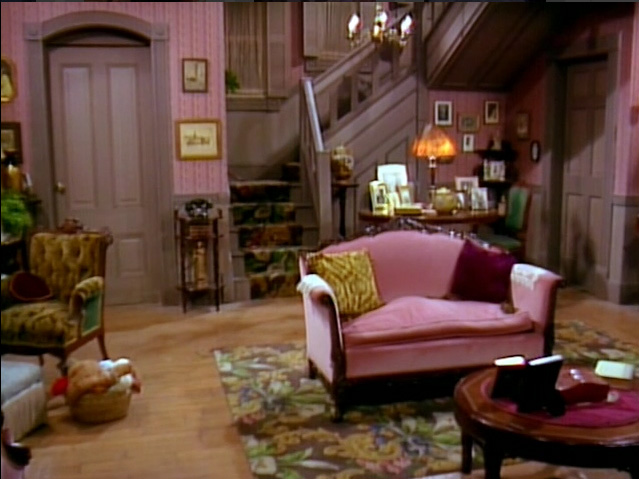 Although concepts and movements like Mid-Century Modern now loom large in our collective re-imaginings of the past, viewers nonetheless continue to identify with the sets on The Golden Girls because the nostalgic pull remains strong across generations. Indeed, my mom says that she remembers a design similar to the banana leaves in Blanche’s bedroom on curtains in her own childhood home in Oklahoma in the mid-1950s.
Although concepts and movements like Mid-Century Modern now loom large in our collective re-imaginings of the past, viewers nonetheless continue to identify with the sets on The Golden Girls because the nostalgic pull remains strong across generations. Indeed, my mom says that she remembers a design similar to the banana leaves in Blanche’s bedroom on curtains in her own childhood home in Oklahoma in the mid-1950s.
Safari designs and color palettes were also popular in the 1970s, which is perhaps what makes the Martinique pattern such a memorable touchstone for viewers young and older. Yet, with its mauve carpeting, chairs, and paint accents, Blanche’s bedroom still represents perhaps the most on-trend space of the set. As my husband asked when we watched The Boy In the Plastic Bubble recently on late night TV, “What was with all the damn green in the ‘70s?” A worthy and legitimate question, to be sure, because the color certainly dominated the era. Known primarily as Avocado, it joined other earth tone staples such as Harvest Gold, Sunflower, and Jute Brown in homes across America. Other colors like Practical Beige and Afternoon feature as background shades on the walls of The Golden Girls set, allowing the other design touches and accessories around the rooms to truly pop. These color choices are another important feature of the show’s set design that endear it to the collective memory of viewers. As noted previously, green was big in the 1980s, and, if you need any more proof that it remains as popular as ever, Pantone’s Greenery was named the Color of The Year in 2017, following Emerald just a few years earlier in 2013.
As we seem to be slinking deeper into the Reagan-era politics of the original Golden Girls run, it only makes sense that 1980s design elements would make a comeback once again. Ed Stephenson’s meticulously crafted sets brought decades of interior design into focus—reflecting the combined life experiences of the show’s characters—to create a singularly memorable sitcom. Choices such as color, furniture style, and accessory placement continue to create a powerful bond in the minds of viewers. As Rue McClanahan reminds us in a 1985 New York Times article about the initial success of the show, “The truth is we all still have our child, our adolescent, and our young [self] living in us.” Whether viewers remember the sets through the lens of nostalgia or as more of a retro backdrop, the interior design elements continue to reinforce the lasting impact of The Golden Girls as a show that defied sitcom conventions to maintain relevance into the 21st century.
![]() Claire Sewell is a librarian and the author of The Golden Girls Fashion Corner blog. She shares her thoughts about many random and wondrous things on Twitter at @clairesayswhat.
Claire Sewell is a librarian and the author of The Golden Girls Fashion Corner blog. She shares her thoughts about many random and wondrous things on Twitter at @clairesayswhat.
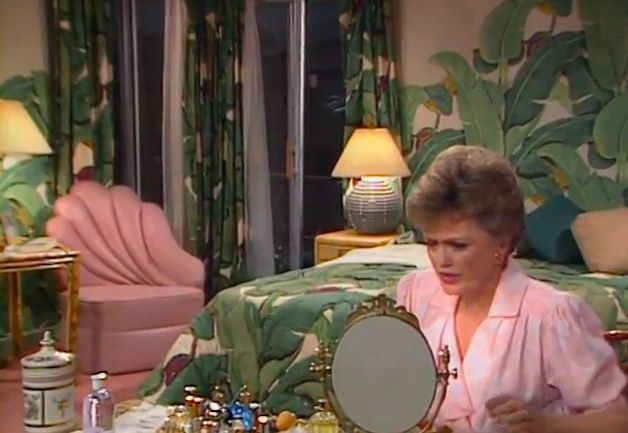




Pingback: Picture It: The Golden Girls and Interior Design Nostalgia – Golden Girls Fashion Corner
I just want to tell you how much I have always adored the GG. I love the 21st century updates on the furniture. Blanched bedroom always leaves me looking around for snakes and bugs. The update is gorgeous. All the rooms are gorgeous and charming
Pingback: A Brief History of Sophia’s Purse – Golden Girls Fashion Corner
Pingback: Golden Girls House Layout - Home Floor Plans Architecture Ideas
Didn’t the Beverly Hills Hotel make the Martinique pattern popular? I’ve always associated it with the hotel (reading more than experience). From this article I don’t get the impression that the GG house changed all that much over the years but in watching select episodes, it seems to me that the LR and K either change quite a bit, or the lighting does… And doesn’t the lovely 1940s tropical sofa and chairs also go away at some point (I’m tempted to take pictures of the TV screen so I can compare).
Hi there! I think it’s fair to say that yes, the Beverly Hills Hotel popularized the Martinique pattern before The Golden Girls. The topical sofa and chairs in the living room remained throughout the series, although some of the furniture in Blanche’s room changed later on. Cheers!
Pingback: Happy anniversary, Babe . . . – The Golden Girls Fashion Corner